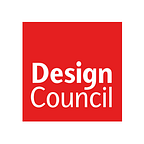Can we revolutionise design to build a Re-Industry?
Designing a circular economy is now an urgent need.
Hugo Jamson, Programme Lead, Design Council
Circularity is big news. The volume of discussion and debate on the subject has tripled over the last three years, but we’re still a long way from achieving meaningful mass-scale circular business, design, consumption and policy.
Brilliant innovations and experiments are taking place across the globe, from consumer goods and electronics to fashion, textiles, packaging and furniture — but these innovations are still the exception, not the norm.
Of the 100 billion tonnes of materials which enter the global economy each year, only 8.6% are recycled.
The share of recycled materials consumed by the global economy is decreasing, with a 21% drop over the course of five years. A shocking fact is that in the last six years alone we have consumed the same quantity of materials as we did in the entire 20th century.
What can design do?
We know that design is critical in developing profitable products and services (every £1 spent on design generates around £20 revenue) and in determining the sustainability or circularity of a product or service from the very outset (about 80% of the total environmental impact of a product is determined at the design phase).
Yet design is, for too many businesses, not yet part of the skillset that will support them on their sustainability and circularity journey. We saw in our Design Economy research that two-thirds of businesses use design in their practice, but that only one-third plan on using design in their green transitions. This needs to change.
The challenges of designing for mass circularity.
Businesses are operating within linear economy structures. They are relying on proven and profitable linear business models, often with teams siloed and not working effectively on connected solutions. This can lead to uncoordinated industrial activity with too little collaboration within and across sectors and between businesses.
There is a lack of skills. Designers lack skills in designing for circularity and face challenges when convincing design commissioners that they are best placed to connect their commercial, sustainability and customer ambitions.
Consumption is a habit. It’s become second nature, but we need to unlearn and design out this behaviour, fast. We know a third of the UK’s emissions reductions must come from a change in consumer behaviour.
We need governance and leadership. There is currently a disconnect between circularity and policy, with confusion over timelines, scope and their application in the design process and in business planning. Government can play a crucial role in leading the way.
Introducing the Re-Industry programme
The Design Council is embarking on an ambitious new Re-Industry programme to support a mass scale-up of circularity for consumers and industry.
The programme will align emerging policy, commercial and consumer realities with circular design practice to accelerate a new norm, where products are routinely repaired for reuse, resold, refurbished, remanufactured, or reduced to composite elements for recycling. It will work across four key areas:
- Launching collaborative projects across sectors that demonstrate a shift from competitive to collaborative advantage within businesses and between them.
- Creating resources and opportunities that place an upskilled design sector at the centre of visioning and commercialising complex sustainability challenges.
- Working with partner businesses, designers and wider stakeholders to create prototypes of mass circular products, services and experiences that are comparable to, and exceed linear ones.
- Encouraging policy integration into design commissioning from the outset, and helping make policy requirements a widely understood part of the day-to-day design process.
Designing for mass circularity means building new collaborations across all of these areas. An upskilled design sector, a culture of circular consumer behaviour and policy that enables integrated circular products, services and business models. We need this to work seamlessly together and be able to scale up quickly if we are to build a Re-Industry and design an economy that is better for us and our planet.
